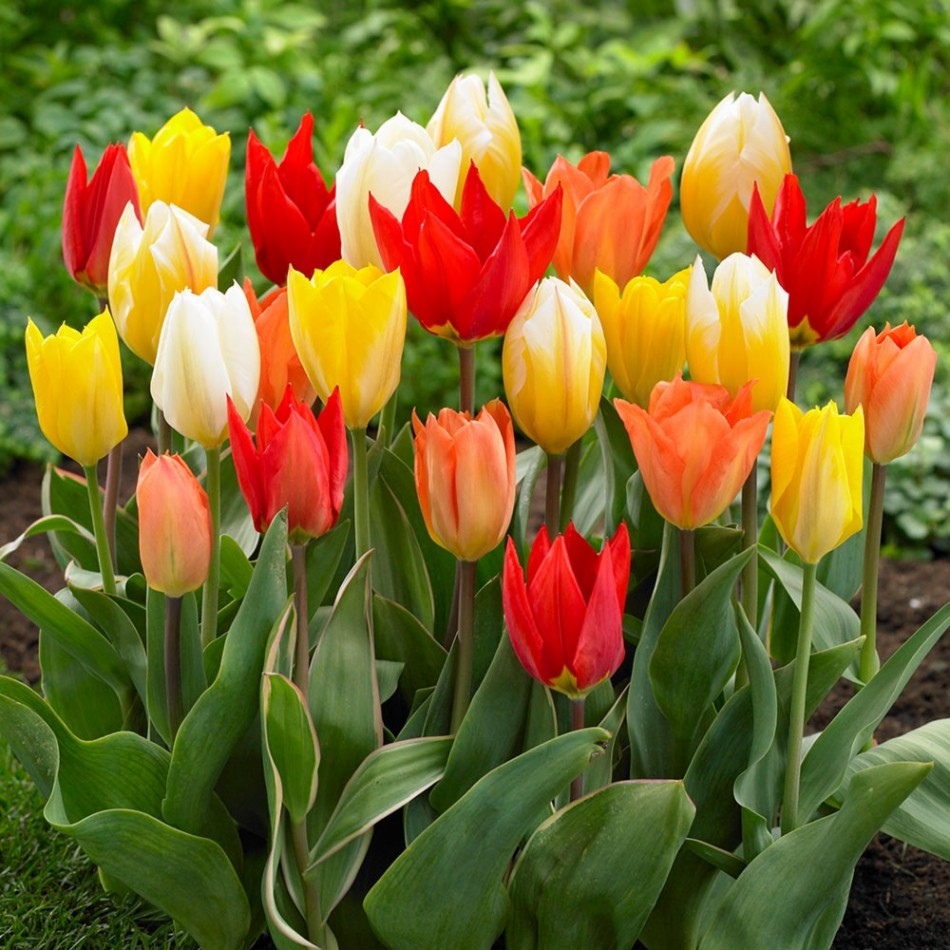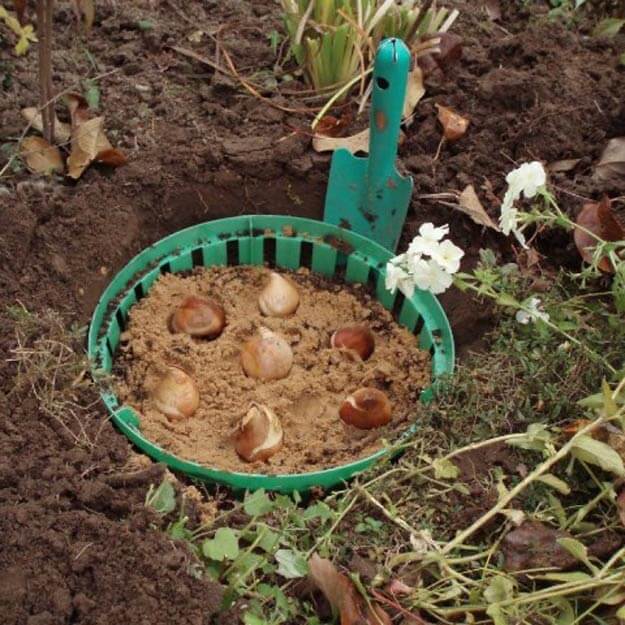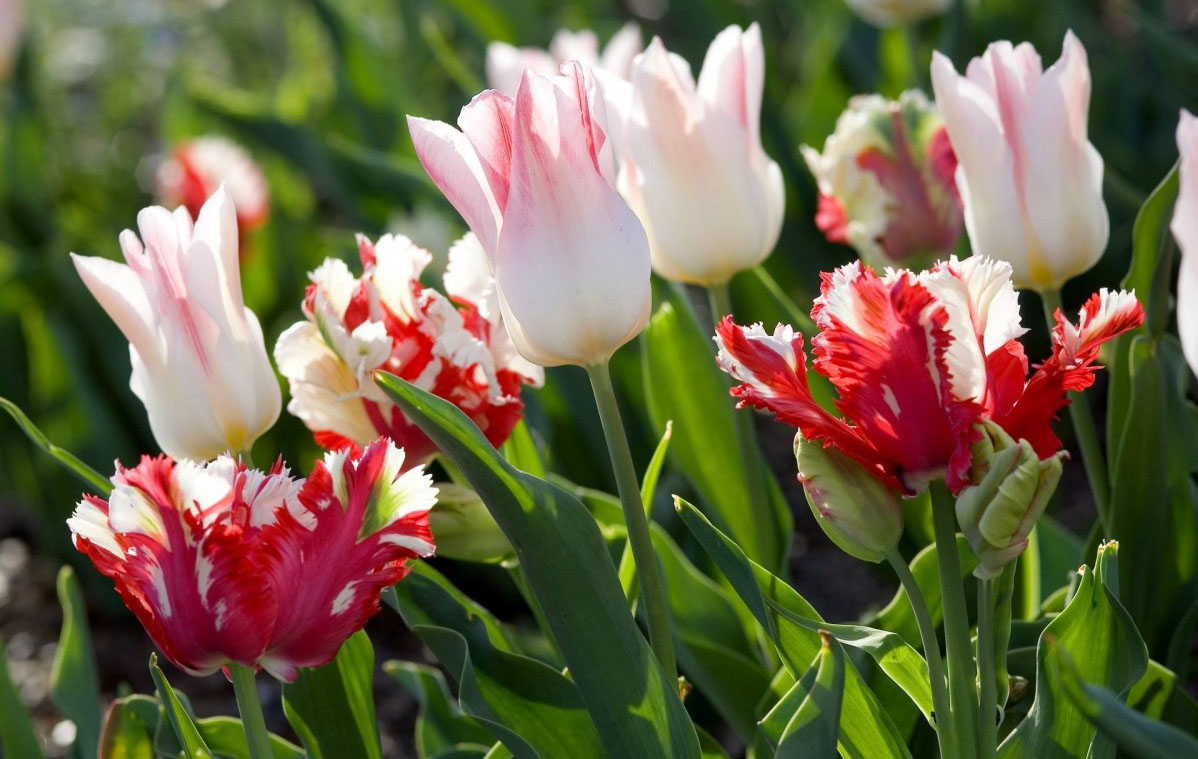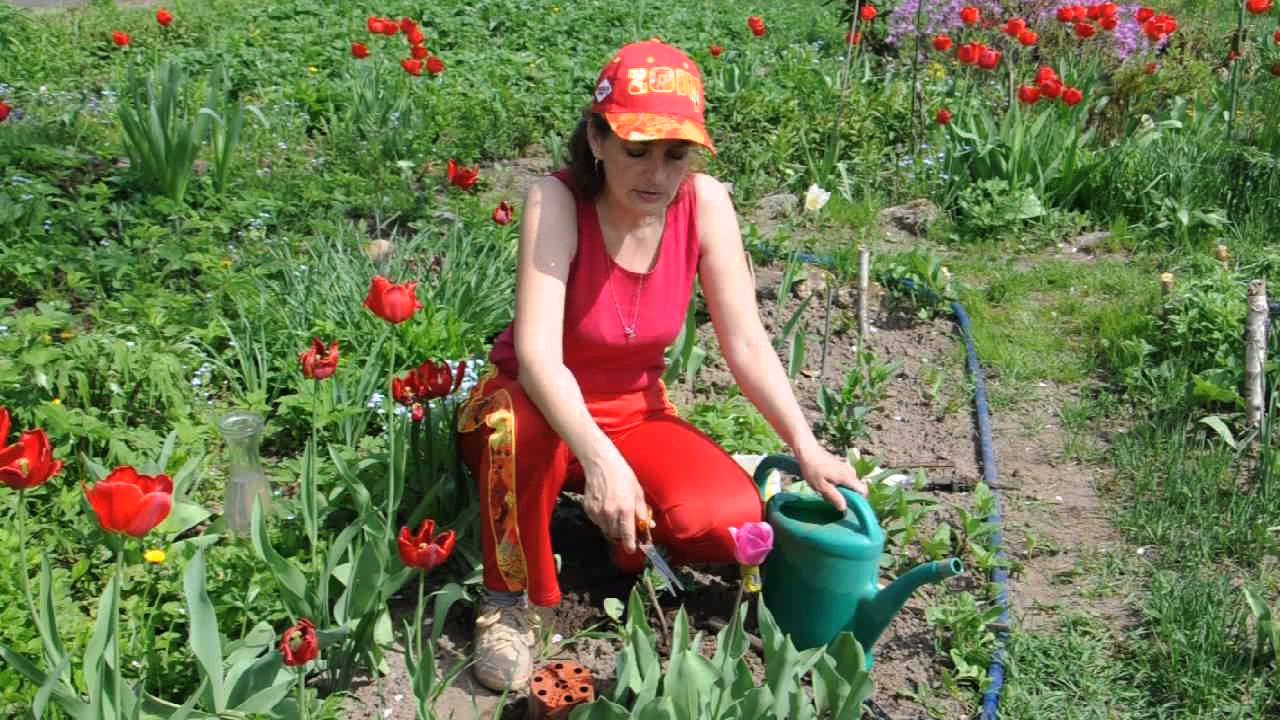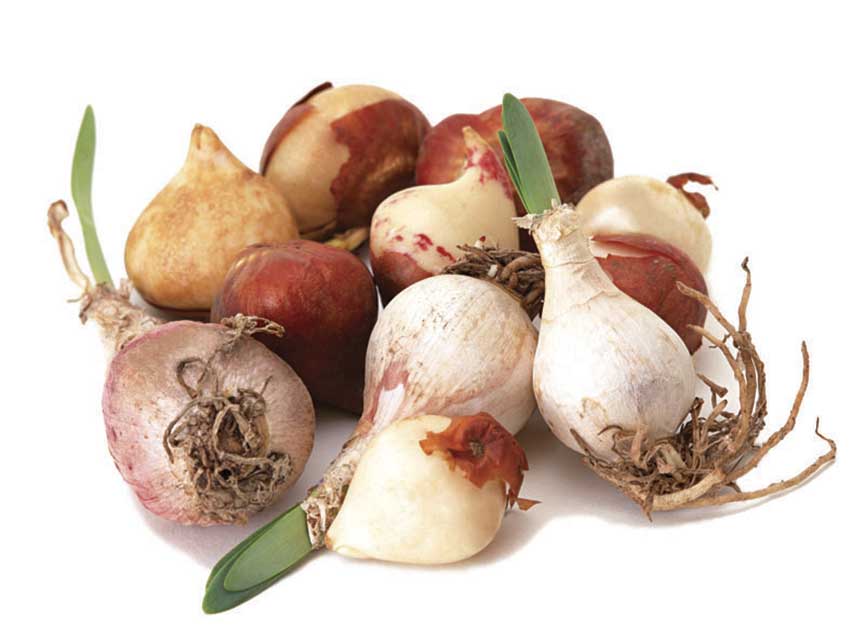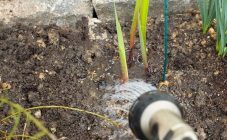Content:
Tulips are one of the earliest flowers in spring. Every novice gardener can grow them, they are not difficult to care for. They can be planted both in a small area, densely both in a flower bed, and in large long rows. For this, special trenches are dug. For their full development, their bulbs must be removed from the ground, dried and planted further. The features of the process and stages of cultivation and storage of flowers will be discussed below. The article is devoted to working with certain species of this plant, when and how to dig up tulip and daffodil bulbs for transplanting.
Why do they dig up tulips
Many people ask themselves: is it necessary to dig up tulips? Most bulbs need to be dug up every year and then replanted. This happens because the old bulb dies off and a new one appears in its place, almost always there can be several of them. Breeders have even developed varieties that can reproduce quickly, with more than 2-3 bulbs. If you do not dig them out annually, then they will stop blooming, since there will be too many tubers and a struggle will begin for space and tightness in the soil. A tight fit can also be dangerous for disease.
What varieties of tulips do not need to be dug
Botanical species do not require transplanting. They multiply very slowly, so they do not have a high stocking density. These include the Kaufman, Foster and Greig tulips. They are not popular as they mainly plant the tulips that need to be dug up.
The Kaufman class is represented by low-growing flowers, which grow to a maximum of 30 cm, but mostly 17 cm. They have small, but decorative flowers. Especially popular varieties: Giuseppe Verdi, Glack, Fashion, Herts Delight, Johann Strauss.
Foster's tulips are dwarf species, the height of which is up to 15 cm, although there are also those that reach 40 cm.They have cupped and goblet buds, they do not bloom for long. Most common varieties and hybrids: Sylvia van Lennep, Honorose, Passion, Sweetheart.
Greig's species are as short as the tulips listed above. They have cupped flowers with sharp petals. Popular varieties: Pinoccio, Echo, Ali Baba, Cape Cod, Plaiser, Princesse Charmante. The latter has very large flowers up to 10 cm.
However, these species can also be dug out, but not annually, but once every few years, in order to also prevent dense plantings.
When to dig up tulip bulbs for transplant
The timing and months of this process differ depending on the geographic location. The following describes when to dig up tulips and how to store them until planting in the fall. For example, in the southern regions of Russia, tulips should be dug up in June - July, to the north in July - early August, in the central regions in late July - early July.
Favorable dates when you need to dig up tulips for transplanting according to the lunar calendar:
| Month | Number |
|---|---|
| May | 25-28 |
| June | 7,8;11,12;14,15; 21-25 |
| July | 3,4;8-12;17-22;31 |
| August | 1-9;13-18 |
In the spring, when they bloom, planting is not recommended. This can lead to shredding of the bulbs, and as a result, there will be fewer plants next year.You need to dig it out when the upper leaves turn completely yellow, and the lower ones will be slightly yellow. This means that the onion has exhausted itself, and there are not enough nutrients in the soil.
How to dig up tulips correctly
To do this, it is worth choosing sunny weather, the land in the flowerbed should be dry. Earlier species are dug first, then middle and later ones.
It is forbidden to uproot it, you need to carefully remove it, then it will not go anywhere.
Garden nets and boxes are very popular when planting. You can use a cut potato mesh bag. They need to be dug into the ground, then the future baby, which forms on the bulb, will remain in the net. This will facilitate further collection in the fall.
After digging, the soil from the tubers and roots must be cleaned off, the leaves and stems must be cut off. Then the roots are removed and the bulbs are sorted. Damaged during collection, for example, with a shovel or a pitchfork, can be treated with iodine, but provided that they are minor.
If it so happens that the weather is rainy, then it is worth rinsing the bulbs and drying them. If any damage is found, then it must be treated with a disinfectant solution, and then dried again well. Diseased bulbs are not usable and should not be kept with others. This must be strictly monitored, otherwise it is possible to lose all tubers.
The disinfecting solution is diluted in the following proportions: 1 liter of water at room temperature + 1 tbsp. a spoonful of salt. You can add a spoonful of baking soda for more effect.
The next 2 days, the bulbs are dried in the sun, cleaned of leaves and dirt, selected by varieties and distributed in boxes.
If the tubers are dug up too early, then you can still fix the situation. To do this, you need to return them to the ground and wait for the foliage to turn yellow and wither, and then repeat the procedure: remove and dry.
There is another option - send them for storage along with the rest. Florists write that the survival rate with this method is also high.
What to do with tulip babies after digging
The bulbs on which there are babies must also be stored. True, the timing will be much shorter than that of conventional bulbs. They dry out faster (in a few days). Regarding their further fate, the opinion of flower growers differs: somewhere they write that they need to be planted earlier, thereby allowing them to grow, but the best option is to plant in August, and cover with a small layer of humus on top to keep them from damage for the winter.
How to store tulips before planting in the fall
It should be laid in a thin layer to ensure normal thermoregulation and oxygen supply. For small ones, they use bags, for large ones - boxes. The room should be warm and humid enough, but in moderation. In a damp place, they will rot and mold. It is worth checking the bulbs periodically and removing the affected ones to avoid spoiling all flowers. They don't need light.
You need to distribute the bulbs in accordance with the size:
| Category | Bulb diameter, cm |
|---|---|
| Large or extra | 4 |
| 1 analysis | 3,5-4 |
| 2 parsing | 3-3,5 |
| 3 parsing | 2,5-3 |
| Baby 1 | 1,5-2,5 |
| Baby 2 | Less than 1.5 |
For varieties with a high multiplication factor, special conditions are needed so that they can be stored without problems:
- in August, the storage temperature should not exceed 20 ° C;
- in September - October - 14-17 ° С.
The rest of the tulips have an average reproductive rate, and this is the vast majority. They should be stored at 20 ° C, which is lowered by 3 ° in October.
Poorly breeding varieties need a different temperature regime: in summer - 24 ° С, in autumn - up to 24-27 ° С, and by October they need to be reduced to 17 ° С.
Indoor humidity should not exceed 70-80%.
Maintaining a special climate for the bulbs is very important, the quality and quantity of bulbs that can be planted in the future depend on this. At this time, buds and daughter bulbs are laid.
When to plant tulips
Before planting flowers, it is worth considering the possibility of leaves drying in mid-summer, which does not look very aesthetically pleasing. To do this, you need to plant the bulbs next to summer flowers so that their bushes then cover the fading tulips.
You cannot trim the leaves immediately after flowering. To the bulbs there is an outflow of nutrients that are needed for proper growth and the appearance of children. An infection can penetrate through the cut, because it is not protected by anything. Flower buds can be trimmed, it is even useful. Then they will not waste energy on the generation of seeds.
The best time for planting is considered to be autumn, September and early October, when the soil temperature is 6-10 ° C. Landing is possible later in November. But then you should take care of covering the tulips with leaves or other equipment.
Planting too early can cause the bulbs to become ill, as higher temperatures encourage the development of viruses. If planted later, the onion may not develop sufficiently.
For planting, it is better to choose a dry, windless place where the sun's rays penetrate. Grow well on any fertilized and cultivated soil. Loose, humus-containing soil is most suitable. Can also be planted in clay soils, provided that it is fertilized with compost or peat. The main thing is that there is no stagnation of water, otherwise in winter the bulbs can be exposed to diseases or simply freeze.
When planting, you can and even need to use special bulb fertilizers. You can buy them at specialized stores. They contain all the essential minerals and nutrients that are needed for normal growth and development.
Before planting, you need to look at all bulbs for damage and diseases. Selected tulips must be treated with a solution of potassium manganese acid for 1 hour. It is worth planting in the garden immediately after treatment.
For the extra class, the planting depth is 17 cm, the second and third fences are planted at a depth of 13 cm, there are even fewer children - about 7-9 cm.It is not worth pressing into the soil so as not to damage the roots.
If planting is carried out on dry soil, then the furrows must first be watered abundantly with water, then put fertilizer and sprinkle with earth. Only after this is the bulb itself planted to a depth of 9-10 cm with the roots down.
Features of digging tulips in the Moscow region, in the Urals and Siberia
This process is no different from the rest of the area, except for the month when you dig up tulips. It is important to know not only when to harvest tulips, but also when it is better to plant them.
In the Moscow region, tulips are dug in late June - early July. Dug out, starting from the early varieties, depending on the analysis. In the Urals, the bulbs are taken out to dry, in July, but in Siberia, later than anyone else, at the very beginning of August.
Otherwise, all stages are standard, with the exception of planting and soil preparation.
The most dramatic difference is the landing stage in Siberia.If in other regions flowers are planted at a relatively shallow depth, then here it should be at least 25 cm, otherwise the bulbs will freeze in severe frosts. With a deeper planting, the tubers will develop worse and shred. River sand is poured onto the bottom of the bed, the laid out bulbs are sprinkled with rotted manure, and then earth, which is leveled with a rake. In spring, the plants are covered with a film or other material so that temperature drops do not adversely affect the flowers.
The planting depth in the Urals is 15-20 cm. The flower bed itself should be spacious, take up a lot of space in the garden, and the soil should be loose with an abundance of sand for better growth, especially if the soil is clay. As a fertilizer, you can use ammonium nitrate or phosphorus complex fertilizing. They are brought in 3 times a year. Prepare the soil 2 weeks before planting, dig up and water. Bulbs are insulated in winter. For this, spruce branches are used. You can cover with a small cap of snow.
When to dig up and plant tulips in the Moscow region? Slightly alkaline, humus-rich soils are suitable for planting. In the fall, manure is introduced with the addition of sod soil and compost. Just like in Siberia, river sand and green fertilizer are added, which will contribute to better development and growth. Fresh manure can be added up to 3 days before the planned planting. For 2 months, they dig up and level the territory, but do not apply fertilizers. In the Moscow region, the growing season lasts about 2-3 months. At this time, you need to feed with easily digestible mixtures. The distance between the bulbs should be kept no more than 23 cm.
Tulips definitely need care. Special attention should be paid to storage and planting. But, if you follow all the rules described above, then there will be no problems with this, and they will decorate the flowerbed every year and delight with flowering. The main advice is to take into account the peculiarities of the landing region.
